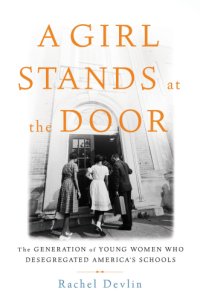
Ebook: A girl stands at the door: the generation of young women who desegregated America's schools
Author: Devlin Rachel
- Tags: African American girls--Education--History--20th century, Civil rights movements, Civil rights movements--United States--History--20th century, Discrimination in education, Discrimination in education--United States--History--20th century, Educational equalization, Educational equalization--United States--History--20th century, School integration, School integration--United States--History--20th century, Segregation in education, Segregation in education--United States--History--20th century, Nonfiction, La
- Year: 2018
- Publisher: Basic Books
- City: United States
- Edition: First edition
- Language: English
- epub
"Long before the landmark Brown v. Board of Education ruling in 1954, the struggle to desegregate America's schools was a grassroots movement--and young women were its vanguard. In the 1940s parents and daughters began filing desegregation lawsuits, eventually forcing Thurgood Marshall and other civil rights lawyers to take the issue to the Supreme Court. After Brown v. Board, girls also far outnumbered boys in volunteering to desegregate all-white schools. [This book] transforms our understanding of one of the twentieth century's most significant civil rights battles, revealing a movement set in motion by deeply committed, savvy, and resilient girls and young women. Among them were Lucile Bluford, who fought to desegregate the University of Missouri's School of Journalism and became the movement's leading chronicler as a reporter and editor; Marguerite Carr, Doris Rae Jennings, and Doris Faye Jennings, teenagers who became the public faces of desegregation cases years before Brown; and the many young women who stood up to enraged protestors, hostile teachers, and hateful white students while integrating classrooms across the Deep South. Drawing on personal interviews and new archival research, historian Rachel Devlin explains why black girls were seen, and saw themselves, as best suited--and thus most responsible--for the arduous labor of reaching across the color line in public schools. A bold and surprising new history of school desegregation, A Girl Stands at the Door shows how the extraordinary bravery of young black women made racial integration in schools a political priority and an imaginable reality. Illuminating their unrecognized leadership, Devlin reminds us to see women's ongoing work in social movements for racial equality today."--Jacket.;"A new history of school desegregation in America, revealing how girls and women led the fight for interracial education The struggle to desegregate America's schools was a grassroots movement, and young women were its vanguard. In the late 1940s, parents began to file desegregation lawsuits with their daughters, forcing Thurgood Marshall and other civil rights lawyers to take up the issue and bring it to the Supreme Court. After the Brown v. Board of Education ruling, girls far outnumbered boys in volunteering to desegregate formerly all-white schools. In A Girl Stands at the Door, historian Rachel Devlin tells the remarkable stories of these desegregation pioneers. She also explains why black girls were seen, and saw themselves, as responsible for the difficult work of reaching across the color line in public schools. Highlighting the extraordinary bravery of young black women, this bold revisionist account illuminates today's ongoing struggles for equality"--Amazon.com.;Roots of change: Lucile Bluford's long crusade -- "This lone negro girl": Ada Lois Sipuel, desegregation champion -- Girls on the front line: grassroots challenges in the late 1940s -- Laying the groundwork: Esther Brown and the struggle in South Park, Kansas -- "Hearts and minds": the road to Brown v. Board of Education -- "Take care of my baby": the isolation of the first "firsts" -- "We raised our hands and said 'yes we will go'": desegregating schools in the mid-1960s.
Download the book A girl stands at the door: the generation of young women who desegregated America's schools for free or read online
Continue reading on any device:

Last viewed books
Related books
{related-news}
Comments (0)